Celebrating Holy Week in Spain and the PhilippinesPrepared by Harold Stephens
Travel Correspondent for Thai Airways International
Easter is here and most Christian countries around the world will be celebrating, and Thai Airways flies to these destinations with Royal Orchid Holidays offering vacation packages there. Two countries that really go all out during Easter are the Philippines and Spain.
Spain is the most famous country in the world for its Holy Week traditions. Seville and Malaga see the most glamorous celebrations, while those of Castille-Leon see the more sombre and solemn events. My favorite is Seville.
Holy Week, known as "Semana Santa”, is a tradition that dates from medieval times. The festival is notable for featuring the procession of "pasos", lifelike wood or plaster sculptures of individual scenes of the events that happened between Jesus' arrest and his burial. Pasos are physically carried on the shoulders of costaleros (body builders) and can weigh up to five metric tonnes. Those who precede the Paso are dressed in Roman military costumes or penitential robes. Brass bands accompany the groups, playing funereal religious hymns or "marchas" written for the occasion.
Holy Week in the Philippines is something else, and it may take a strong stomach to witness one. In this largely Roman Catholic nation, Semana Santa is the most important religious festival of the entire year. Good Friday, the day Jesus was crucified, is commemorated with street processions which include devotees who self-flagellate their bodies. And there are those who have themselves nailed to crosses as expressions of penance.
Ever since I saw photographs of flagellations and crucifixions in the Philippines, I wanted to go to Manila during Holy Week and see if they were real or fiction. I finally went, and when I arrived in Manila I learned that a young girl was going to go through the ordeal. It's not unusual for men to be nailed to a cross, but for a young girl, it was unheard of. Why was she doing it? What was her motive? Could she be a religious fanatic? I wanted to meet her.
Here name was Precila Almario, and through a Manila newspaper I was able to find the village where she lived. I contacted her family and her father invited me to witness the drama. It took two hours to get to her village by bus and another hour by taxi to find her house, located in a slum area with unmarked streets. When I knocked at the door, a young girl appeared and, when she said she was Precila, I was taken back by her youth. She couldn't have been more than 13 or 14. She later assured me she was 18.
Although shy and a bit nervous, she seemed fairly composed for a person who was going to be crucified in two days. Her father, an out-of-work laborer, appeared at her side. He picked up the conversation. His daughter was not a crazy masochist. By letting herself be crucified, she could find fulfillment by making a panata, a sacred vow. The panata in this case was not for past sins or wrongdoings, nor was it for a future life after death, but for a promise of something better for her and her family in this life.
The crucifixion was to take place in an open field at Bulacan, some 30 miles from Manila. Precila was not only going to be crucified but she had to carry her heavy cross through the streets while thousands watched. When they asked if I would like to come to the chapel with them on Good Friday morning, I said I would.
I had been witness to other strange and bizarre religious gatherings in Asia over the years and I was uncertain what course this one might take. Only a week before I arrived in Manila I had attended a Hindu gathering at Batu Caves north of Kuala Lumpur. It was Thaipusan. Hindu devotees there submit themselves to incredible self torture by driving long spikes through their flesh and carrying kadavi, a large fan-shaped religious altar of sorts, above their heads supported by skewers stuck into their flesh. I watched half crazed Hindu fanatics carry their heavy burdens up 276 steps to a cave deep in the mountain above where priests removed the kadavis and withdrew the spikes and skewers—and there was no blood or wounds to show. Their secret, I learned, was self-hypnosis, a trance they put themselves into. But nothing can be compared to those who let themselves be crucified and hung on crosses. As I stood there talking to Precila, this young innocent girl, I was still finding it hard to believe.
In a sense, the Philippine nation as a whole puts itself into a trance during Holy Week. Each Filipino is deeply embedded in his own interpretation of Christianity mixed with pagan beliefs. On Good Friday every town and barrio in this country, numbering some 7,152 islands, plunges into a meditation on death.
The cenaculo, the Philippine version of the European Passion play, is acted out in every plaza. Christ's seven last words are mumbled on everyone's lips. Flagellants, who wear white cotton hoods to mask their identity and over which are placed crowns of thorns, take to the streets and lash their back with glass-spiked leather thongs.
Along the streets in the provinces from Cavite in the south to Pampaga in the north, both young and old alike stumble along carrying heavy wooden crosses in emulation of Christ's march to Calvary. In Bulacan, crucifixions on the cross take place.
I arrived in Bulacan in the early morning on Good Friday. The heat of day had already begun and people by the masses were arriving in taxis, buses, jeepneys and private cars. At the edge of the field, where the crucifixions were to take place, police had road barriers set up and here everybody disembarked.
In the distance, across open rice fields now turned brown, there was a church with two high bell towers, and nearby was a man-made hill with a wooden platform on top. Here was their Calvary.
After half an hour, we reached the site where stone steps led to the top of the hill. A kilometre away was the church; I had to push through the crowds to reach it. Suddenly the crowd parted and a troop of Roman soldiers appeared wearing togas and waving spears and sabers. Behind them came a young, bearded man with a crown of thorns on his head and carrying a cross. He would be the first to be crucified.
I arrived at the church in Precila’s village as she and her family were coming out. She was ready for her final march to Calvary. I felt a sudden pang of pity for her. She looked tired and worn.
She wore a brown, loose fitting sack-like skirt and a white blouse. She was barefooted. As she stepped into the churchyard, two soldiers stepped up and seized her by the arms. A look of bewilderment and fear came to her eyes. Her mother began wailing; her father stepped aside. They stood in a kind of disbelief that this was happening to their daughter but It was now beyond their control.
The soldiers placed a crown of thorns on her head and lifted the cross to her shoulder. The weight almost toppled her over. She began struggling forward. The crowd stepped aside to let her pass.
It was agony, every step. She slipped once, twice. Her knees were bleeding. Blood ran down her shins and dried with the dust kicked up by her bare feet as she struggled along. She perspired profusely. Her blouse was wringing wet with sweat and dust. Her mother, who had been following in her footsteps, turned away and slumped on the wayside. Her father remained with her.
I pushed ahead to find a place on the stone steps. Another woman martyr, an old lady in her late 60s, reached the top of the steps as I arrived. The lines on her face were drawn tight. She lowered her cross to the floor and faced the crowd. She had a look of terror in her eyes.
A soldier held two huge nails in one hand and in the other hand he clutched a heavy hammer.
That poor old lady looked at the soldier and then the nails. She hunched her shoulders, slouched back and withdrew. The crowd booed and she left. Precila was next. Would she too change her mind?
She approached the steps. The cross was too heavy for her to carry up the steps so the soldiers nudged her, helping her to lift the heavy burden. Once she reached the top, like the old lady before her, she lowered the cross to the floor. I worked to a position directly behind her. A sea of bewildered faces looked up and stared at us.
I could feel her agony now. She stretched her arms out as though she was pleading, asking forgiveness from all those gathered before her. Thick dust was gathered on her arms and legs. She began to tremble slightly.
The soldier, her executioner, stepped forth with the nails and hammer. He stood before her, saying nothing. She lowered her eyes. She accepted the crucifixion.
The soldier turned to the crowd. Like a magician who shows his audience that his tools of trade are real, he held up the nails and hammer for all to see. Precila was then tied to the cross, a band around her waist one around each forearm. The cross was then lifted into place.
Some precaution was taken. The nails were washed in alcohol. Precila's moment of truth had arrived.
She turned her head slightly. The expression on her face did not change. The soldier placed the point of a nail against the palm of her right hand—she lifted her eyes to the sky—and with one blow of the hammer he drove the nail into her hand. Three times the hammer struck, driving the nail deeper into the wood with each blow. He then nailed her left hand to the cross. Blood ran down her arms and dropped to the rocks at the base of the cross.
Twenty-five martyrs were crucified in Bulacan that Good Friday. One crucifixion took place outside of Bulacan, at the maximum-security compound of the National Prison, where a convict, who was awaiting the death penalty, was crucified.
I watched when Precila was lowered from the cross and the nails removed. The pain, while pulling the nails out, was more agonizing than when they were driven in. She passed out and was carried from the platform through the crowd to the church. I followed her and then lost her, and later found her again kneeling in church. Her hands were cupped together swathed in white bandages. Her smiling happy family stood at the back of the church and greeted friends. They shook my hand when I arrived. They paused for a picture with Precila in front of the church. She had her reward— the two nails used in the crucifixion. I watched her and her family disappear down a dusty lane and I walked back across the empty field to where my taxi waited. I looked back and Calvary hill was deathly still. The crucifixions were over.
Next week I will tell readers about golf in Thailand. QUESTIOINS & ANSWERSQ. “Dear Mr. Stephens, I feel in love with Thailand during a five-day R&R from Vietnam 30 years ago. I understand Thailand has greatly changed since then. I’d like to bring my wife and introduce her to some Thai culture and Thai ways. Is that still possible in our modern world?” -- Roger Loomis, Vermont, USA
A. In deed, it is possible. Royal Orchid Holidays has just the thing for you called Experience Thai Life (ROHE2O). You travel by boat and van to your destination and spend a night in a Thai home, an actual wooden houses built on stilts. You live the way the Thais do. Your meals are typical Thai, prepared by your Thai hosts. In the early morning hours you watch or participate with the villagers as they offer food to the monks, who arrive there by rowing boats. You couldn’t get closer to Thai ways and culture.
Next week I will tell you more about the advantages if joining a tour, and what tour groups offer that travel on your own doesn’t. After that, in the weeks to come, I’ll take readers on some exciting trips. Stay tuned.
Harold Stephens
Bangkok
E-mail: ROH Weekly Travel (booking@inet.co.th)
Note: The article is the personal view of the writer and does not necessarily reflect the view of Thai Airways International Public Company Limited | 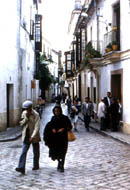
Quiet street before the Holy Week in Seville | | 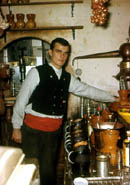
The cafes are open for taps and copas | | 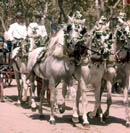
Parades during Holy Week | | 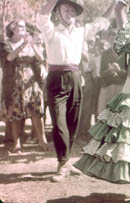
Gypsy dancers celebrate | | 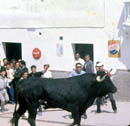
You even have bulls running through the streets | | 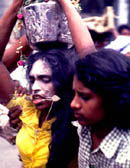
Thaipusan ceremony in Malaysia | | 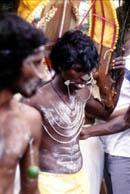
Also as tough as being nailed to the cross | | 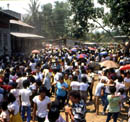
A gathering crowd during Holy Week in the Philippines | | 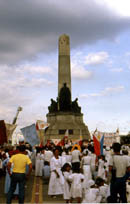
Even a dark cloud looms above for a crucifixion | | 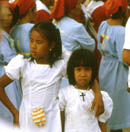
Every Filipino has the faith | | 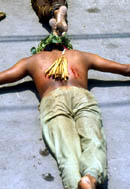
Self-flagellate seen in the streets | | 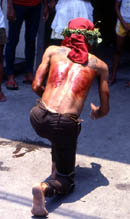
People come to see the flagellations | | 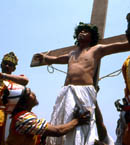
A Filipino submits to be nailed to the cross on Good Friday | | 
Look, real hammer, real nails | | 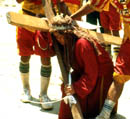
An 18-year old Filipina lifts the cross she must carry | | 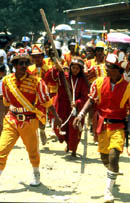
Roman soldiers in sunglass and Nike shoes edge her on | | 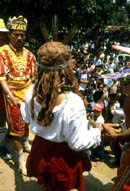
Looking down upon those waiting to witness the ordeal | | 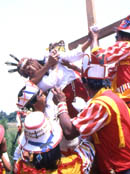
Precila comes down; more painful than the nailing | | 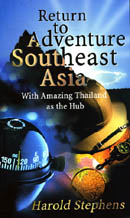
For more about bizarre ceremonies read the author's Return to Adventure | | 
Next we will looking in golf in Thailand |
|





